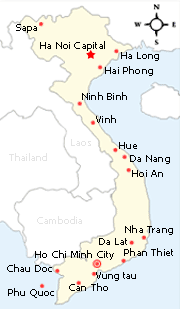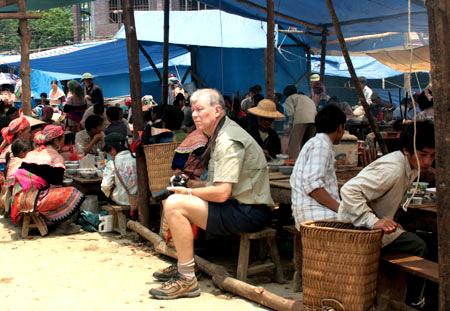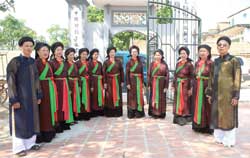Vietnam Culture & PeopleGoing out to sea in dug-out canoes in the early morning, fishermen in My Khe, Da Nang city, return home in the afternoon with big catches of fish on some days and with bare hands on other days.
In the past, fishermen could know where there were fish, shrimp or cuttle-fish based on the experience. But now, many fishermen have search machines.
VietNamNet/VNE Post By: admin
Dong Van Plateau in Ha Giang Province consisting of Quan Ba, Yen Minh, Dong Van and Meo Vac Districts contains great geological values, suitable to developing a model of sustainable socio-economic development.
Vision of a project Professor, Doctor Jan Masschelein from Leuven University, Belgium has researched geology of caves and grottos in the mountainous areas in Northern Vietnam for over 15 years. He said discoveries on Dong Van Plateau by scientists showed that the plateau is a world’s natural heritage that needs to be preserved. Therefore, not only local people but also nature lovers should take responsibility for preserving, embellishing and developing it for benefits of the people. Professor Michiel Dusar, Director of the Belgian Geological Department was very interested when he set foot on this superb plateau. He said that he had visited many places in the world but no other place had left such a strong impression on him like this area. It boasts a system of caves and grottos as well as a fantastic and poetic landscape. At many international seminars and field trips, the scientists had a common idea that the optimal model for Dong Van Plateau was to build it into a geological park of national and international stature. I still remember a field trip to Lung Cu area with Professor Okke Batalaan from Brussels University (Belgium). Standing at a height of 1,800m above sea level he looked very delighted while contemplating ranges of mountains and hills of the plateau below. He said that with painting-like landscape and many customs which are very attractive to visitors, Dong Van Plateau is worthy of being a geological park. In the eyes of the scientists, Dong Van Plateau is beautiful and mysterious but it has slept for years. Moreover, it is in danger of desertification and human devastation. Therefore, the protection and preservation of its discovered values is an urgent task. The establishment of the Vietnam-Belgium Geological Park project on the basis of co-operation between the Vietnam Institute of Geosciences and Mineral Resources, the Kingdom of Belgium and Ha Giang Province (Vietnam) is a sound decision to preserve and protect the geological and geomorphologic heritages and valuable landscape, and promote the socio-economic activities and sustainable development. Nguyen Truong To, Chairman of Ha Giang Provincial People’s Committee said that the Vietnam Institute of Geosciences and Mineral Resources and its partners in the country and from Belgium are helping Ha Giang Province work out a document to build Dong Van Geological Park on an area of 2,300km2 and submit it to UNESCO for consideration to be recognized as a global geological park. Promoting economic and tourist development Doctor Tran Tan Van, Deputy Director of the Vietnam Institute of Geosciences and Mineral Resources, who has been attached to geology for dozens of years, said that the geological park project is aimed at hunger elimination, poverty reduction and sustainable development, on the basis of educational and training activities for preservation of nature and reasonable use of natural resources. The establishment of Dong Van Geological Park will have a great significance in popularizing the values of this rocky plateau, especially developing the economy and tourism. Standing on the peak of Ma Pi Leng Mountain which connects the districts of Dong Van and Meo Vac we had a feeling of being in a vast windy park. This area has beautiful scenery and unique geology. In front of us, there is Pai Lung Mount which is called a geologic monument by scientists. The Nho Que River looking like a silk band snakes through rugged cliffs which are 800-1,000m high. From this height we could contemplate peaks of mountains that look like pyramids running one after another.
The unique natural values of Dong Van Plateau together with the typical cultural features of the ethnic groups have created a sustainable vitality in the area. The Khau Vai Love Market, second to none in Vietnam, helps create a strange attractiveness to this area. It takes place once a year, on the 27th of lunar March, in Khau Vai Commune of Meo Vac District, a place name connected with a legendary love story. The market is not only a rendezvous of men and women who can not become husbands and wives but also a meeting place of young people. The market has become an attractive destination for domestic and foreign visitors. Stones are available everywhere, in the terrace fields and in the home, where rice mortars, beds and horse stables are made of stones. The most beautiful feature is the earthen-walled houses surrounded by a stone barricade of the Mong ethnic people.
Dong Van, a border area of Vietnam, is home to 17 ethnic groups including the Mong, Tay, Lo Lo, Pu Peo and Giay. Through many years they still retain their traditional cultures, such as the going-to-the-field festival, the new rice-worshipping ceremony, the panpipe dancing festival, etc. In particular, Dong Van Market is very impressive. It is not only a place for product exchange but also for cultural activities. Young Mong ethnic men express their feelings by playing the panpipes while young women in charming brocade dresses sing songs in response. Couples and friends sit around a large pot of Thang co to enjoy the food and drink maize wine. The ancient city of Dong Van has the shape of a bow stretching several kilometres. The house in the city has the architectural style of the mountainous area, with stone-paved floor, earthen walls and a yin-yang tiled roof. The local people are optimistic and hard-working. To grow maize on rugged mountains, they have to carry baskets of soil to the mountain and place the soil into the hollows on the rock before sowing the seeds. We visited Dong Van Plateau several times and each time we had a different feeling due to its distinct seasons. It is warm in winter and cool in summer. In the rice ripening season, the terrace fields in Hoang Su Phi constitute an emotive artistic work. The weather is favourable for growing fruit trees, such as peach, pear, plum and apple as well as precious medicinal plants, such as Eucommea, Tsaoko, Duong quy, Slipper plant, Job’s tears and Shan tuyet tea. These products have created the potential for the plateau to develop. Visit Dong Van Plateau you will enjoy and never forget its beauty bestowed by nature.
Story by Hoang Chuong Photos by Hoang Ha – Ngo Du – Tan Van – Vinh Hung – Cong Hoan – Thanh Phuong - Post By: admin
Bac Ha fair opens every Sunday in Bac Ha district, the northern mountainous province of Lao Cai. The fair is known for its cultural identity of ethnic minority people.
The fair attracts not only domestic tourists but also many foreigners who come to look for colourful brocade, skirts of Mong ethnic minority people and specialities of the mountain region.
VietNamNet/Nhan Dan Post By: admin
Tree frog species are the most beautiful amphibians in Vietnam. Sixteen species of tree frogs have been discovered in the country at different heights, from 100 to 3000 m above sea level. Tree frogs live in well-protected forests only and they need to be protected. Tuoi Tre introduces the beauty of some tree frog species. 1/ Living at the height of 3000m above sea level, the tree frog species named Rhacophorus dugritei lays its eggs in early April to avoid the cold spell in the winter in Fansipan, the highest mountain in Indochina. This is the tree frog species living at the highest height in Southeast Asia.
2/ Living at the height of 2400-2500m is Rhacophorus hoanglienensis species. This species was discovered in 2001 by Vietnamese and Russian scientists in the Hoang Lien National Park. It is very difficult to take pictures and collect samples of this species in nature, even for amphibian researchers.
3/ Chư Yang Sin Rhacophorus chuyangsinensis was discovered in 2008 at the height of 2200m in Chu Yang Sin National Park. This species of frog is very beautiful because its skin and eyes combine yellow, dark brown, red, black and green.
4/ With shiny blue skin with black spots, a white stomach and suckers on their feet, Rhacophorus dennysi is among the best climbers and long jumpers of amphibians in Vietnam.
5/ Rhacophorus calcaneus is the smallest tree frog species in Vietnam. They like dense forests with many streams.
6/ Rhacophorus kio often lives in places where there are waterfalls and high humidity. Sometimes they are seen in recovering forests in Vietnam.
7/ With blazing red stomachs that look like ripening fruits in the forest and silver white backs, Rhacophorus rhodopus is very special.
8/ Rhacophorus annamensis experiences great changes of appearance during their growth process. Amphibian experts who don’t research this species may be surprised about its changes.
9/ Even enemies of Rhacohorus feae cannot recognise them if they are standing on a fresh tree branch because its colour is similar to leaves and branches in forest.
10/ German amphibian experts Ziegler and Kohler discovered Orlovi Rhacophorus olovi species in the central province of Ha Tinh. This is an endemic species in Vietnam.
11/ It is possible that this is the tree frog species that lives at the lowest height in Vietnam. In 1999, Russian and German scientists found them in the Central Highlands province of Gia Lai, at the height of 900m above sea level. In 2000, they were discovered in the Vinh Cuu Nature Reserve in the southern province of Dong Nai.
12/ Living on the Yen Tu range of mounts in Quang Ninh province, Rhacophorus maximus can stand firmly on bamboo, cane brakes and other trees on stream banks to seek food.
Source: VietNamNet/Tuoi Tre Post By: admin
Villagers in the northern province of Bac Giang continue to preserve the ancient quan ho (love duets of Northern Delta). Hoac Cong Cho is just an ordinary old man in Trung Dong Village, in the northern province of Bac Giang. But when the locals talk about him, everyone in his village in Van Trung Commune, Viet Yen District, would say he is their own artisan and folklorist. At 74, Cho is very healthy and quick. Locals say he is like a piece of living heritage in terms of his knowledge of quan ho. His eyes shine brightly when he talks about these love duets. "Our villagers composed and sang love duets many hundreds of years ago. My grandparents and parents were members of the village’s quan ho troupe during the feudal era. "I learned how to sing from my mother since I was little. When I grew up, I studied folk music at the provincial Arts School." Over the past 50 years, Cho has always been the motivation behind raising the village’s singing movement. Today he is the head of the local quan ho club, with its 28 elders ranging in age from 53 to 89. Though most of them are old, whenever Cho calls, all of them will show up and be ready for a performance. "Since before the August Revolution in 1945 until now, our village has always had a few troupes. For any events, such as festivals, we can easily mobilise about 50 people who can sing," he says. Cho lives with a special passion for quan ho, which led him to collect and preserve a lot of materials related to the village’s ancient folk songs. These include books that store ancient lyrics and a list of singers who have passed on. Showing off his books, Cho says: "I collected their names to prove that quan ho has existed here for a long time." Also precious treasures are the more than 100 ancient songs that he found and recorded after travelling and searching for them around the region. Cho says about 130 ancient folk songs have been recorded and he is still able to sing dozens of them. The songs tell the stories of daily lives mixed with classic references and folk ballads. They are both natural and full of love. Cho points out a few differences between the quan ho in Bac Giang Province and the nearby Bac Ninh Province. "Our lyrics are different from the quan ho in Bac Ninh Province, and we also sing slower." Cho currently teaches his skills to younger villagers for free. His students voluntarily and enthusiastically learn how to sing the ancient songs. His oldest student is Vu Thi Sau, 77, who studies along with her daughter and daughter-in-law. Seven members of the Hoac family, including Cho’s elder brother Hoac Cong Tao, 89, and elder sister Hoac Thi Chuong, 82, also sing with the troupe. Hoac Thi Chuong says she remembers that during her childhood, she went with her parents to sing in the nearby village. "We loved singing and we did our best to finish all of our work during the day, so that in the evening we would have time to go to the communal house to sing through the night. "During these nights, we did not feel tired from the singing, and we never wanted to sing the song "Say Farewell To Friends," she recalls. "Now I stay and you leave me, just tell each other good things. I hold a cup of salt in one hand and a dish of ginger in the other hand. Acrid ginger and briny salt remind us that we should not forget each other. My darling, as we love each other we should keep our promise..." After she finished singing a song, Chuong says: "My voice is not as strong as it used to be, so I often sing the short verses. My daughter can sing many longer songs, both old and new." Every week, on Saturday afternoon, the troupe gathers in the communal house to practise. At times, members also gather at Chuong’s house. If one of the members has collected a new song, all of them stay together to practise. Folklorists and music researchers have visited the village many times. "We admire them not only because of their special love for quan ho, but also for their will to overcome material difficulties," says folklorist Dr Bui Quang Thanh from the Institute for Culture and Arts, who has spent years studying folk songs from the region. The troupe does not have common funding from local authorities or other sources; members generally have to spend their own money to purchase costumes. "The commune is still poor so we can hardly earmark a part of the budget to help the club. We have to maintain local art, and we have to base that on socialisation. We call for local organisations and individuals to help support the operation of the club,"says the commune’s Party Secretary Hoang Van Khiem. Cho says folklorist Thanh recently gave each elder gifts of VND200,000 (US$10). Happily, the provincial Department of Culture, Sports and Tourism recently gave the troupe VND9 million ($486) to help acquire costumes. "Authorities should pay more attention to us. We are getting older and older. Without proper attention from the authorities, I am afraid the old art may disappear forever," Cho says. Hoac Cong Tao, 89, says he went with his parents to singing sessions during his childhood. The elder still remembers most of main local tunes, including: Anh Hai Tai Tu (An Amateur), Tam Mat Xuong Song Dao (Bathing in the Dug River), Chot Thuc Day Sao Mai Long Lanh (Wake up and See the Morning Star), Doi Ta Nhu Chi Moi Xe (We Are as Closely Associated as Fresh Thread) and Tay Cam Bau Ruou Nam Nem (Holding a Wine Gourd and Meat Roll in Hand). "We are too old and feel tired. We don’t wish for anything greater; we only wish for the Government to recognise our cultural heritage," Tao says. Bui Quang Thanh says because of the limits on socio-economic conditions, researchers have yet to complete many thorough studies about the values of this village’s ancient folk songs. "Among the ancient quan ho villages on the northern bank of the Cau River, this village has the highest number of elders who are still able to sing. They are 70-80 years old but they still have very good voices. "Compared to other villages, the quan ho of Trung Dong has special features in their lyrics and different ways of expressing the various musical tones. "With today’s alarming situation that could see ancient folk songs fall into oblivion, we need to conduct more studies and develop conclusions for preserving the precious value of the love duets from the northern bank region of the Cau River." Hoac Cong Cho, on behalf of the members of his troupe, affirms their passion for traditional love duets. "We established our troupe to preserve the ancient cultural values of our homeland. Without pay or material support from the Government, we still sing. This is our love for the ancient heritage that we inherited from our ancestors. "We would be devastated if our village’s love duets were to disappear - we could all leave the world anytime. Without funds, the young generation would not want to follow the heritage of our forefathers."
Source: VietNamNet/VNS Post By: admin
|












































